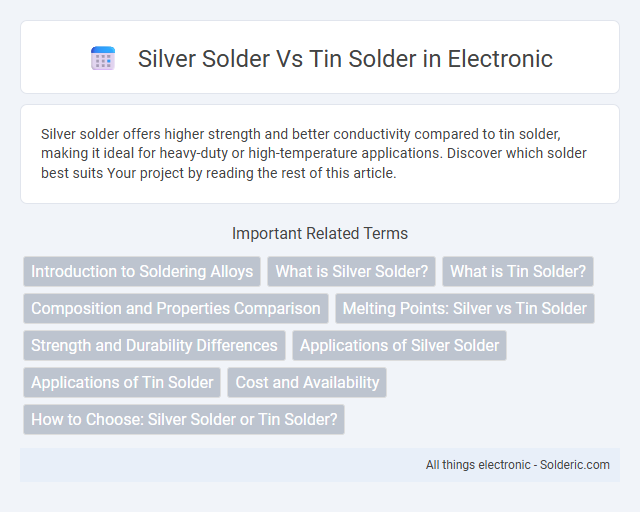Silver solder offers higher strength and better conductivity compared to tin solder, making it ideal for heavy-duty or high-temperature applications. Discover which solder best suits Your project by reading the rest of this article.
Comparison Table
| Feature | Silver Solder | Tin Solder |
|---|---|---|
| Composition | Alloy of silver, copper, zinc | Alloy of tin and lead or tin and other metals (lead-free options) |
| Melting Point | 620 - 780degC (1148 - 1436degF) | 180 - 230degC (356 - 446degF) |
| Strength | High mechanical strength | Lower mechanical strength |
| Applications | Jewelry, plumbing, HVAC, metal joining requiring strong bonds | Electronics, electrical wiring, delicate metal joints |
| Corrosion Resistance | Excellent | Moderate |
| Cost | Higher due to silver content | Lower, widely available |
| Health & Safety | Requires ventilation due to flux fumes, higher temp | Safer; low temp; lead-free versions reduce toxicity |
| Ease of Use | Requires higher skill and temperature control | Easy to use, suitable for beginners and electronics |
Introduction to Soldering Alloys
Silver solder offers higher strength, better thermal conductivity, and superior corrosion resistance compared to tin solder, making it ideal for demanding applications like jewelry or aerospace. Tin solder, commonly used in electronics, melts at a lower temperature and provides good electrical conductivity, simplifying assembly and repair. Understanding the alloy composition helps you select the right solder for your project's mechanical and thermal requirements.
What is Silver Solder?
Silver solder is a high-temperature alloy primarily composed of silver, copper, and zinc, used to join metal pieces through brazing. It offers superior strength, corrosion resistance, and excellent electrical conductivity compared to tin solder, making it ideal for critical applications in plumbing, jewelry making, and electronics. This type of solder melts at temperatures typically between 620degC and 780degC, allowing for strong, durable joints on materials like brass, copper, and stainless steel.
What is Tin Solder?
Tin solder is a type of soft solder primarily composed of tin, often combined with lead or other metals to enhance its properties. It is widely used for electrical and electronic applications because of its excellent conductivity and relatively low melting point, which prevents damage to sensitive components. Your choice of tin solder is ideal for creating reliable, corrosion-resistant joints in wiring and circuit board assembly.
Composition and Properties Comparison
Silver solder typically contains a high percentage of silver (20-50%) mixed with copper and sometimes zinc, offering superior mechanical strength, thermal conductivity, and corrosion resistance. Tin solder is primarily composed of tin (30-60%) blended with lead or other metals, providing lower melting points and better electrical conductivity but reduced durability compared to silver solder. The chemical composition difference directly influences their melting temperatures, with silver solder melting between 620-780degC and tin solder between 180-230degC, affecting their suitability for high-temperature and precision applications.
Melting Points: Silver vs Tin Solder
Silver solder typically melts between 620degC and 780degC, making it suitable for high-temperature applications requiring strong, durable joints. Tin solder, with a lower melting point around 180degC to 230degC, is ideal for delicate electronics and tasks where heat sensitivity is a concern. Choosing between silver and tin solder depends on the required melting point for specific industrial or hobbyist applications.
Strength and Durability Differences
Silver solder offers superior strength and durability compared to tin solder, making it ideal for high-stress applications and metal joining that requires long-lasting bonds. Its higher melting point and corrosion resistance contribute to a robust joint capable of withstanding extreme temperatures and mechanical wear. Tin solder, while easier to work with and suitable for electronics or low-stress projects, lacks the tensile strength and longevity of silver solder in demanding environments.
Applications of Silver Solder
Silver solder is commonly used in applications requiring strong, durable joints that can withstand high temperatures and mechanical stress, such as jewelry making, HVAC systems, plumbing, and aerospace components. Its superior thermal and electrical conductivity make it ideal for intricate metalwork and electronic assemblies where precision and reliability are crucial. You benefit from silver solder's ability to create corrosion-resistant, high-strength bonds on metals like copper, brass, and stainless steel.
Applications of Tin Solder
Tin solder is widely used in electronics due to its excellent electrical conductivity and low melting point, making it ideal for circuit board assembly and delicate components. Unlike silver solder, which is preferred for high-strength and high-temperature applications, tin solder excels in creating reliable, corrosion-resistant electrical connections. Your choice of tin solder ensures precise, efficient bonding in small-scale and consumer electronic repairs.
Cost and Availability
Silver solder generally costs more than tin solder due to the inclusion of precious metals like silver, which increases material expenses and affects your overall budget. Tin solder is widely available, commonly used in electronics and plumbing, making it more accessible and affordable for everyday applications. Choosing between the two depends on your project's demands, balancing cost with the specific properties required.
How to Choose: Silver Solder or Tin Solder?
Selecting between silver solder and tin solder depends on the application's temperature requirements and joint strength. Silver solder offers higher melting points around 600-800degC and superior mechanical strength, making it ideal for metalworking or plumbing applications requiring durability. Tin solder melts at a lower temperature, approximately 180-230degC, and excels in electronics and delicate components due to its excellent electrical conductivity and ease of use.
Silver solder vs tin solder Infographic

 solderic.com
solderic.com